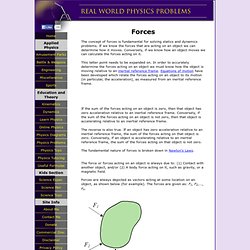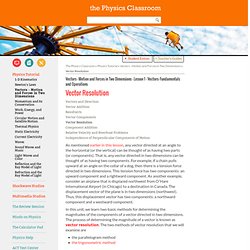

Forces. The concept of forces is fundamental for solving statics and dynamics problems.

If we know the forces that are acting on an object we can determine how it moves. Conversely, if we know how an object moves we can calculate the forces acting on it. This latter point needs to be expanded on. In order to accurately determine the forces acting on an object we must know how the object is moving relative to an inertial reference frame. Equations of motion have been developed which relate the forces acting on an object to its motion (in particular, the acceleration), as measured from an inertial reference frame. If the sum of the forces acting on an object is zero, then that object has zero acceleration relative to an inertial reference frame. The reverse is also true. The fundamental nature of forces is broken down in Newton's Laws. Forces are always depicted as vectors acting at some location on an object, as shown below (for example).
Return from Forces to Dynamics page. 1 - Chapter5-ForceMethod.pdf. AZ024 Lecture 8 Distribution of Force in Framed Structure. Forces, Structural Forces, Levers, Struts and Ties. Main Forces A Static Load A good example of this is a person seen below.

He is holding a stack of books on his back but he is not moving. Resolution of forces (application) Vectors and Forces in 2-D: Problem Set. Vectors and Forces in 2-D: Problem Set Problem 1: For each collection of listed forces, determine the vector sum or the net force.

Audio Guided Solution Problem 2: Hector is walking his dog (Fido) around the neighborhood. Audio Guided Solution Problem 3: Helen is parasailing. Audio Guided Solution Problem 4: At one moment during a walk around the block, there are four forces exerted upon Fido - a 10.0 kg dog. Fapp = 67.0 N at 30.0° above the horizontal (rightward and upward) Fnorm = 64.5 N, up Ffrict = 27.6 N, left Fgrav = 98 N, down Resolve the applied force (Fapp) into horizontal and vertical components, then add the forces up as vectors to determine the net force. Audio Guided Solution Problem 5: Jerome and Michael, linebackers for South’s varsity football team, delivered a big hit to the halfback in last weekend’s game.
FJerome = 1230 N at 53° FMichael = 1450 at 107° Determine the resultant force applied by Jerome and Michael to the halfback. Audio Guided Solution Problem 6: Determining the Net Force. If you have been reading through Lessons 1 and 2, then Newton's first law of motion ought to be thoroughly understood.

An object at rest tends to stay at rest and an object in motion tends to stay in motion with the same speed and in the same direction unless acted upon by an unbalanced force. In the statement of Newton's first law, the unbalanced force refers to that force that does not become completely balanced (or canceled) by the other individual forces. If either all the vertical forces (up and down) do not cancel each other and/or all horizontal forces do not cancel each other, then an unbalanced force exists. The existence of an unbalanced force for a given situation can be quickly realized by looking at the free-body diagram for that situation. Free-body diagrams for three situations are shown below. "Resolution Of Forces Assignment Help, Components Of A Force, Magnitude & Direction Of Resultant Force With Solved Examples, Resolution Of Forces -Transtutors " Resultant of Non-Concurrent Force System. Elearning.vtu.ac.in/13/ENotes/ECEEM/GR.pdf.
Vector Resolution. As mentioned earlier in this lesson, any vector directed at an angle to the horizontal (or the vertical) can be thought of as having two parts (or components).

That is, any vector directed in two dimensions can be thought of as having two components. For example, if a chain pulls upward at an angle on the collar of a dog, then there is a tension force directed in two dimensions. This tension force has two components: an upward component and a rightward component. As another example, consider an airplane that is displaced northwest from O'Hare International Airport (in Chicago) to a destination in Canada. The displacement vector of the plane is in two dimensions (northwest). In this unit, we learn two basic methods for determining the magnitudes of the components of a vector directed in two dimensions. Parallelogram Method of Vector Resolution Select a scale and accurately draw the vector to scale in the indicated direction.
Trigonometric Method of Vector Resolution More Practice.